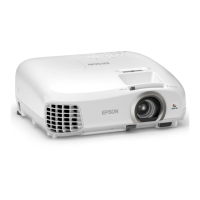
Do you have a question about the Epson PowerLite 2040 and is the answer not in the manual?
| Placement | Desktop, Ceiling |
|---|---|
| Product type | Standard throw projector |
| Product color | Grey, White |
| Matrix type | 3-panel (p-Si TFT active) |
| Number of colors | 1.073 billion colors |
| Native aspect ratio | 16:9 |
| Projection distance | - m |
| Projection technology | 3LCD |
| Supported aspect ratios | 4:3, 16:10, 16:9 |
| Contrast ratio (dynamic) | 35000:1 |
| Contrast ratio (typical) | - |
| Screen size compatibility | 34 - 332 \ |
| Projector native resolution | 1080p (1920x1080) |
| Keystone correction, horizontal | -30 - 30 ° |
| Lamp type | UHE |
| Lamp power | 200 W |
| Light source type | Lamp |
| Service life of light source | 4000 h |
| Service life of light source (economic mode) | 7500 h |
| Focus | Manual |
| Throw ratio | 1.22 - 1.47:1 |
| Optical zoom | 1.2 x |
| Zoom capability | Yes |
| Focal length range | 16.9 - 20.28 mm |
| Aperture range (F-F) | 1.58 - 1.72 |
| Color modes (3D) | Cinema, Dynamic |
| Video color modes | Auto, Cinema, Dynamic, Living room, Natural |
| Analog signal format system | NTSC, NTSC 4.43, PAL, PAL 60, PAL M, PAL N, SECAM |
| DVI port | No |
| Composite video in | 1 |
| USB 2.0 ports quantity | USB 2.0 ports have a data transmission speed of 480 Mbps, and are backwards compatible with USB 1.1 ports. You can connect all kinds of peripheral devices to them. |
| RMS rated power | 5 W |
| Noise level | 37 dB |
| Noise level (economic mode) | 29 dB |
| Power source | AC |
| Power consumption (standby) | - W |
| Depth | 249 mm |
|---|---|
| Width | 297 mm |
| Height | 114 mm |
| Weight | 2900 g |
Details on the projector's key features including resolution and connectivity options.
Lists all items included in the projector's packaging for setup and use.
Information on necessary additional components for connecting various devices.
Details on available projector software and their corresponding manuals for download.
Catalog of optional accessories and replacement parts available for purchase.
Information regarding the projector's warranty and product registration process.
Explanation of symbols and notations used throughout the user manual.
Resources for further help and information on using the projector.
Illustrations identifying the location of various parts on the projector.
Recommendations for positioning the projector for optimal viewing.
Describes different ways to set up or install the projector.
Determining the correct distance for optimal image size and quality.
Instructions for connecting the projector to various input sources.
Steps for connecting and configuring the projector for wired network use.
Instructions for setting up and connecting the projector via a wireless network.
Procedures for safely powering the projector on and off.
How to adjust image height using feet and correct image shape.
Using keystone sliders and buttons to fix uneven image shapes.
Using zoom and focus rings to adjust image size and sharpness.
Using the remote control as a mouse, pointer, or for source selection.
Changing projection modes (Front, Rear, Ceiling) for correct image orientation.
Adjusting the width-to-height ratio of the displayed image.
Selecting and changing color modes for optimal image appearance.
Displaying files directly from a USB device without a computer.
Using A/V Mute to temporarily stop projection and mute audio.
Using the Freeze button to pause video playback.
Enlarging specific parts of the projected image for better viewing.
Setting up passwords and security measures to prevent unauthorized use.
Using the split screen feature to display two images side-by-side.
Saving and scheduling projector commands like power on/off.
Instructions on how to access and navigate the projector's menu system.
Adjusting image quality parameters like color, brightness, and contrast.
Customizing input signal settings for resolution, aspect ratio, and tracking.
Customizing projector features like keystone correction and split screen.
Configuring advanced setup features like display options and projection modes.
Viewing network information and setting up the projector for network control.
Customizing projector settings to save power and extend lamp life.
Displaying projector information such as lamp hours and serial number.
Resetting projector settings to default values or resetting the lamp timer.
Routine maintenance tasks including cleaning lens, case, and air filters.
Step-by-step guide for replacing the projector lamp and resetting the timer.
Guidelines for safely packing, shipping, or storing the projector.
Basic troubleshooting steps for common projector operational issues.
Understanding projector status lights and their corresponding solutions.
Solutions for issues related to projected images and audio output.
Solutions for problems related to the projector's remote control.
Troubleshooting steps for network connectivity and projection issues.
Contact information and support options for Epson technical assistance.
Detailed specifications including display type, resolution, and lens.
Information about the projector lamp type and power consumption.
Specifications for the remote control's reception range and battery type.
Physical dimensions (height, width, depth, weight) of the projector.
Electrical details including power supply and consumption ratings.
Operating and storage conditions for temperature and humidity.
List of compatible refresh rates and resolutions for video display.
System requirements for the computer to use the projector's USB Display software.
Crucial safety precautions for handling and using the projector.
Detailed safety guidelines for setup, use, and environmental considerations.
Regulatory compliance information regarding FCC standards for digital devices.
Details on the open source software used and their associated licenses.
Legal terms regarding dispute resolution, arbitration, and class action waivers.
Information on registered trademarks, logos, and copyright notices.